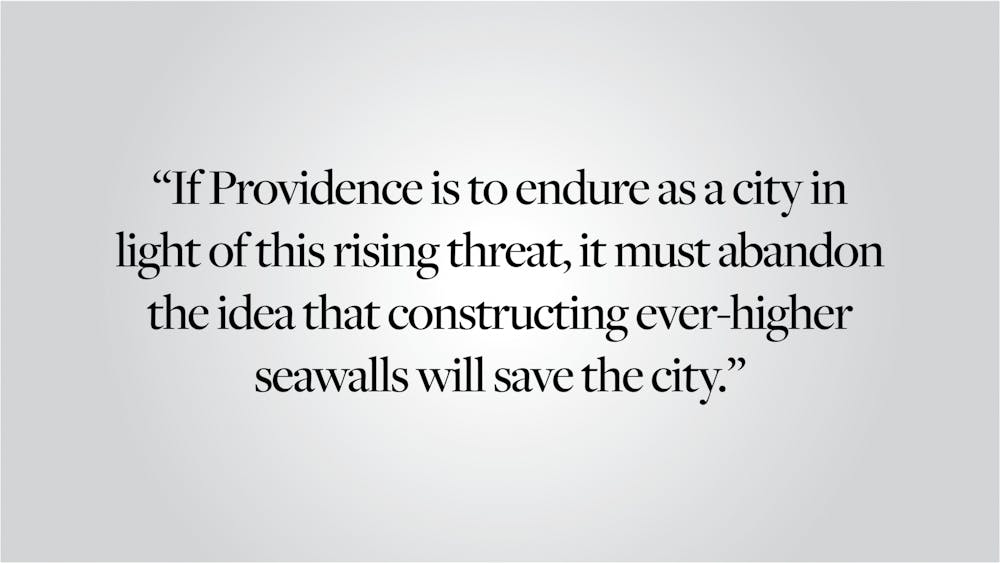Engineers around the world all face the same fundamental challenge: How do we protect flood-prone cities from the rising tide of climate change? Since the 1970s, climate change has caused weather-related disasters to become five times more common and seven times more damaging. What is particularly striking is that of all weather-related disasters, hurricanes in the North Atlantic are seeing some of the most dramatic increases in intensity and frequency. Cities like Providence are also becoming more vulnerable to flooding due to rapidly rising sea levels over the past 50 years. In the 20th century, Providence experienced flooding from both heavy rains and hurricanes. The most important example of such flooding occurred in 1954, when Hurricane Carol created an enormous 14-foot storm surge that left much of the city completely underwater. This led to the construction of the United States’s first anti-hurricane floodgate, the Fox Point Hurricane Barrier, which has been effective at managing water levels and preventing flooding up to today. For example, it protected Providence from Hurricane Bob’s five- to eight-foot storm surge in 1991. Nonetheless, it will be rendered useless against the largest storm surges by the end of the century due to the anticipated rise in sea levels.
If Providence is to endure as a city in light of this rising threat, it must abandon the idea that constructing ever-higher seawalls will save the city and instead embrace a new paradigm of inviting water and native wildlife back into the built environment. Fortunately, the ancient city of Angkor in Cambodia provides a blueprint for how to do so.
In the 13th century, the city of Angkor was one of the largest cities on Earth with a population of over 900,000, according to recent archaeological research. More impressive than its size, however, was the city’s system of water management, which to this day remains one of the most spectacular feats of hydraulic engineering. Angkor had a system of hundreds of miles of canals, earthen dykes and massive reservoirs which together protected the city from the highly variable monsoon rainfall. The canals and green spaces prevented the flooding of the city during particularly rainy monsoon seasons, while large reservoirs supplied water in drier years. The city was thus incredibly resilient against rainfall while also protected against periodic droughts. Further, it was exceptionally sustainable, as farms that provided for the community were dispersed throughout the city. In short, Angkor was designed to use the natural features of the land to prevent water disasters.
While this model of urban planning has largely been forgotten today, it would be far more responsive to rising seas than current designs. Though this model is not necessary for all communities, certain areas of Providence in particular would benefit. Take the neighborhood of Lower South Providence: This neighborhood is just above sea level and parts of the community are at the highest risks of flooding in all of the city. It has also historically been underserved by the city; decades of municipal disinvestment have left vacant housing lots, treeless streets and higher rates of poverty.
Transforming this community into a model for the future of resilient cities would undoubtedly have far-reaching benefits. Primarily, employing the Angkor model by digging canals, dykes and natural green space would leave the community significantly less vulnerable to flooding. At present, many of the wetlands that once surrounded Providence have been paved over, preventing them from acting as “natural sponges” and causing more severe runoff. This, in turn, exacerbates damage from storm surges as all the water flows directly into the bay. Expansion of green spaces will prevent runoff and provide protection for the community, as was demonstrated in Angkor. In addition, the conversion of this community would come with a number of social and economic benefits. Studies have shown that increasing the amount of green space in neighborhoods reduces crime while also increasing economic productivity and physical and mental well-being. This would be transformative for a community like Lower South Providence, which not only suffers from disinvestment, but also environmental injustices like the construction of Interstate 95 directly through the community.
Emulating Angkor does not require building canals and reservoirs. Investments as simple as adding green spaces in cities have been shown in some research to have profound effects. One study on the Argentinian city of Rosario found that additions of green roofs, parks and green spaces reduced flooding, while waterproofing infrastructure had the opposite effect. What Providence can learn from Angkor is not necessarily literal — it’s a shift in mindset about how urban design interacts with the environment.
This plan is undeniably ambitious but should be evaluated against status quo flood defense measures dotting the state and country. Just like the massive hurricane barriers built today in coastal cities, this plan will be expensive. However, unlike such barriers, this plan provides lasting coastal defense while also ameliorating past wrongs. Thus, funds that would otherwise be dedicated to standard flood defenses could be put towards community enhancements, and unlike flood barriers, these will pay for themselves through increased economic productivity. In addition, this plan need not displace any residents by simply reallocating existing land that is currently being underutilized. For example, most streets in Lower South Providence are needlessly wide, and there are a number of abandoned buildings and vacant lots which could be converted to green space.
Ultimately, emulating Angkor would address key issues plaguing not only Providence, but also cities around the world. It provides a highly versatile solution to the problem of rising seas and more powerful storms, ensuring these cities can remain even after their seawalls fail. Equally important, this plan would improve the economic and social dimensions of at-risk communities, which have more than earned investment after suffering under so many decades of neglect.
Gabe Sender is a Staff Columnist at The Brown Daily Herald with a particular focus on campus issues and development challenges in Providence. He is currently pursuing an independent concentration in urban environmentality.





